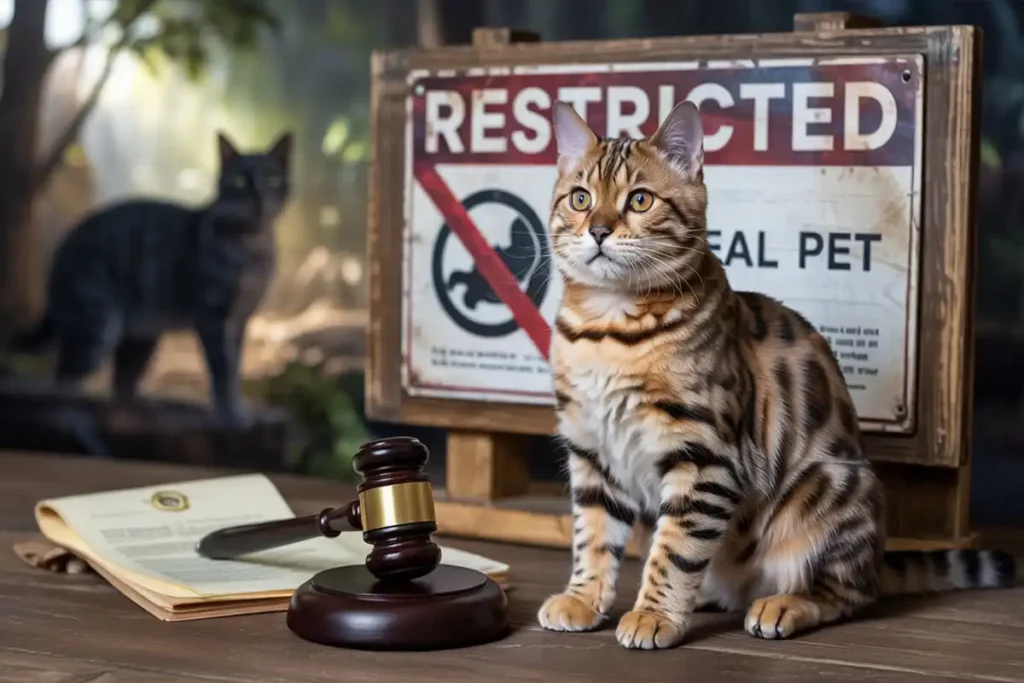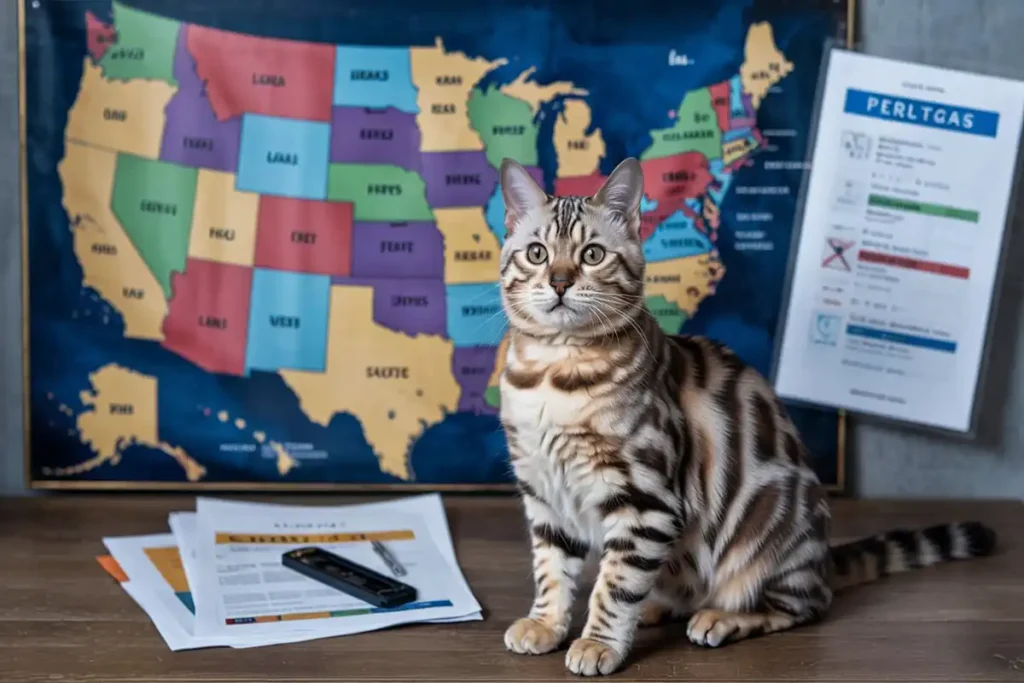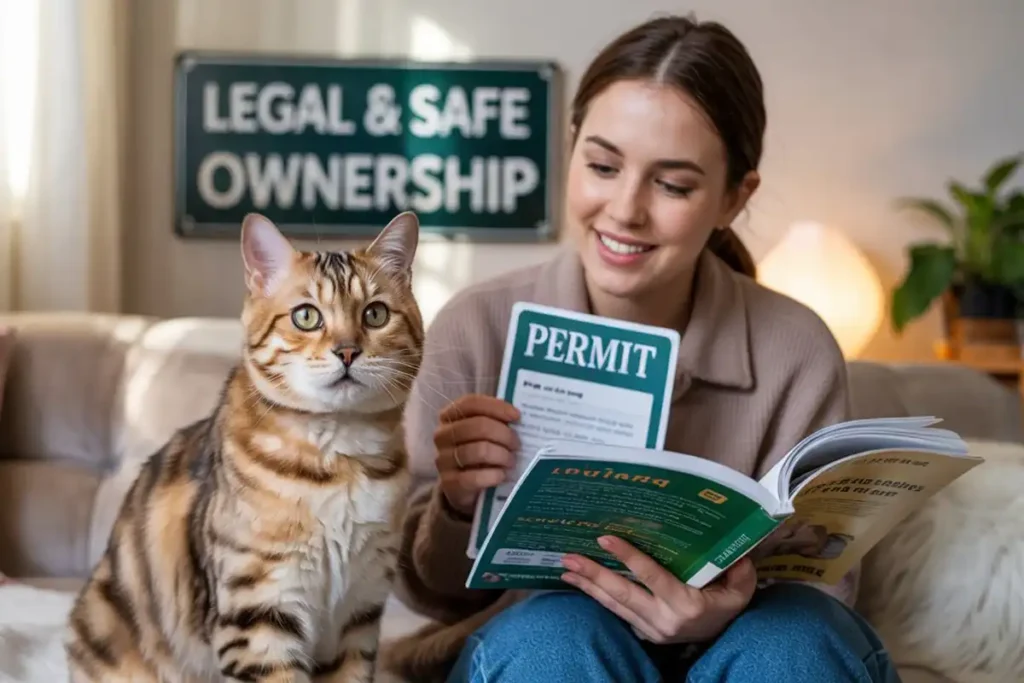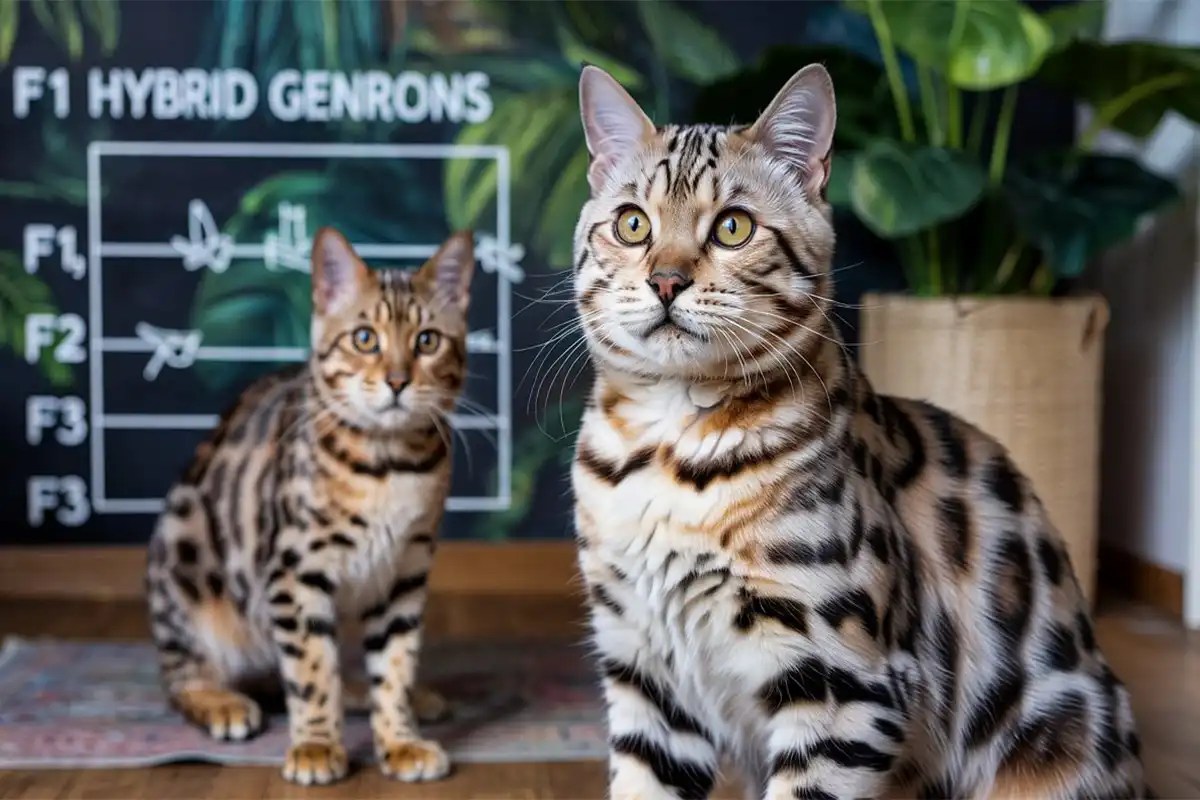Why are Bengal cats illegal? It’s a question that surprises many first-time cat lovers.
They fall in love with the breed’s exotic, wild look.
With leopard-like spots, high energy, and striking beauty, Bengals seem like the perfect mix of wild and domestic.
But many potential owners don’t realize that Bengal cats come with legal issues—especially in some U.S. states.
Bengals aren’t your typical house cat.
They come from the Asian leopard cat, a wild feline species.
This makes them a hybrid breed.
That wild ancestry brings up concerns about behavior, environmental risks, and how well they adapt to homes.
Because of this, many states and animal agencies have rules—or even bans—on owning some Bengal cat generations.
In this post, we’ll explain why Bengal cats face legal limits.
We’ll show how laws change from state to state.
You’ll also learn what it takes to own a Bengal cat the right way.
Whether you already have one or just want to learn more, knowing the legal side is important.
Let’s explore the facts every Bengal cat owner should know.
Understanding Bengal Cats and Their Origins
What Is a Bengal Cat?
A Bengal cat is a hybrid breed created by crossing a domestic cat with the wild Asian leopard cat. Breeders originally aimed to capture the beauty of a wild feline while maintaining the friendly, social temperament of a house pet. The result is a sleek, athletic cat with a distinctive marbled or spotted coat that closely resembles a leopard. Bengals are intelligent, playful, and energetic, often forming strong bonds with their humans.
However, Bengal cats stand apart from typical domestic breeds because of their wild ancestry. This hybrid lineage contributes to their unique behavior, and it’s one of the key reasons why Bengal cats are illegal in certain places. Lawmakers worry that their traits may pose challenges for inexperienced owners or cause issues with local wildlife and ecosystems.
F1, F2, F3 Generations Explained
When discussing Bengal cats, you’ll often hear about different generations: F1, F2, F3, and so on. These labels describe how many generations the cat is removed from its wild ancestor, the Asian leopard cat. An F1 Bengal is the direct offspring of a domestic cat and an Asian leopard cat. F2 Bengals are the second generation, meaning they have one wild grandparent, and F3 Bengals are one step further removed.
These generational distinctions matter not only for behavior but also for legality. F1 and F2 Bengals typically retain more wild traits, such as high energy, strong prey drives, and unpredictable behavior. Because of these characteristics, many states enforce stricter laws on owning early-generation Bengals. Understanding these categories helps clarify why Bengal cats are illegal in areas where hybrid animals face tight restrictions.
Wild Ancestry: The Asian Leopard Cat Connection
At the core of the Bengal cat’s identity is its wild ancestor—the Asian leopard cat (Prionailurus bengalensis). Native to parts of Asia, this small, solitary wild feline possesses incredible agility, a nocturnal lifestyle, and a strong hunting instinct. In the 1960s and 1970s, breeders began crossing Asian leopard cats with domestic cats in an attempt to create a pet with the leopard’s exotic look and the tame personality of a house cat.
This wild ancestry brings both fascination and concern. The closer a Bengal cat is to its wild roots, the more likely it is to display behaviors that don’t align with typical domestic cat expectations. These traits include aggression, marking territory, and resistance to training—factors that help explain why Bengal cats are illegal in several regions with strict hybrid animal laws.
How Bengal Cats Became Popular
Bengal cats exploded in popularity thanks to their stunning appearance and active personalities. Pet lovers were drawn to the idea of having a “miniature leopard” roaming their living rooms, and social media further amplified their appeal. Breeders and cat associations like TICA (The International Cat Association) played a key role in refining the breed to be more domesticated, especially from the F3 generation onward.
Despite their popularity, Bengal cats haven’t escaped controversy. Their demand has led to increased breeding and, in some cases, irresponsible ownership. This surge in interest has put them under scrutiny from animal welfare organizations and lawmakers. In fact, their rapid rise in visibility and mixed behaviors are part of the growing debate over why Bengal cats are illegal in certain U.S. states and cities.
Why Are Bengal Cats Illegal in Some Areas?
Hybrid Cat Restrictions and Exotic Pet Laws
Many states and local governments across the U.S. enforce strict regulations on hybrid cats due to their unpredictable nature and partial wild ancestry. Hybrid animals, especially those that are early-generation mixes like Bengal F1s, often fall under exotic pet laws. These laws are here to keep people and animals safe. States such as New York, Hawaii, and Alaska have outright bans, while others require permits or impose restrictions based on the generation of the cat.

Lawmakers often treat Bengals differently than fully domestic cats because of the potential for aggressive behavior, escape risks, and difficulty adapting to a household setting. These restrictions directly contribute to the growing confusion around why Bengal cats are illegal in certain areas, even though they look domesticated on the surface.
Bengal Cat Ban Reasons: Behavior and Welfare Concerns
Despite their charm and beauty, Bengal cats can be challenging to care for—especially early-generation Bengals. These cats often display high energy levels, strong prey drives, territorial behavior, and difficulty adjusting to typical home environments. While many Bengal owners adore their pets, inexperienced owners may find the breed overwhelming or unmanageable.
Animal welfare groups and lawmakers worry that the average household may not be equipped to meet a Bengal cat’s complex needs. Without proper stimulation, Bengals may become destructive or stressed, leading to behavioral issues and abandonment. These concerns add significant weight to the argument about why Bengal cats are illegal in jurisdictions that prioritize animal welfare and responsible pet ownership.
Role of the U.S. Fish and Wildlife Service
The U.S. Fish and Wildlife Service (USFWS) plays a crucial role in monitoring and regulating exotic species, including hybrid animals like Bengal cats. While the agency does not ban Bengal cats outright, it supports and enforces broader conservation laws that influence hybrid pet ownership. The USFWS works to protect native ecosystems and wildlife, and hybrid cats with wild DNA raise concerns about their potential to disrupt local animal populations if they escape or breed in the wild.
Their involvement in broader exotic animal regulations supports state and federal efforts to limit the spread of invasive or potentially dangerous species. These efforts help explain why Bengal cats are illegal in states that closely follow federal conservation and wildlife protection guidelines.
TICA’s Stance on Bengal Cat Breeding
TICA (The International Cat Association) recognizes Bengal cats as a legitimate and carefully developed breed. The organization allows the registration and showing of Bengals starting from the F4 generation, which are considered sufficiently removed from their wild ancestors to qualify as domestic. TICA also encourages ethical breeding practices and responsible ownership through education and breeder standards.
Even though TICA supports the breed, it acknowledges that earlier generations require specialized care and may not suit typical family environments. Their clear breeding guidelines and classification of generations add clarity to the debate over why Bengal cats are illegal in some areas—especially where early-generation Bengals fall under exotic animal restrictions.
State-by-State Legality of Bengal Cats in the U.S.
Are Bengal Cats Legal in My State?
Bengal cat legality varies widely across the United States, which makes it essential for current and prospective owners to check their local laws. Some states allow Bengal cats without restriction, while others regulate them based on their generation. A few states even ban them completely, especially the early-generation F1 and F2 Bengals, which are closer to their wild ancestry.
Because no single federal law applies to all hybrid cats, individual state governments decide how to classify and regulate them. This patchwork of rules is a big reason why Bengal cat ownership can be confusing—and why Bengal cats are illegal in some places but fully accepted in others just across the border.

Notable States with Bans or Restrictions
Certain U.S. states stand out for their strict regulations or outright bans on Bengal cats. For example, Hawaii completely prohibits all hybrid cats, including Bengals, due to concerns about protecting native wildlife. In New York, Bengals are banned in New York City and some counties, even though they are allowed in other parts of the state. Alaska also bans Bengal cats unless they are at least four generations removed from their wild ancestor.
These state-level decisions are often based on a mix of public safety, environmental protection, and animal welfare considerations. When looking at these policies, it becomes clear why Bengal cats are illegal in specific areas—especially those with fragile ecosystems or a history of exotic pet issues.
Registration and Permitting Requirements
In states where Bengal cats are legal but regulated, owners may need to follow special rules. Some jurisdictions require pet registration, proof of the cat’s generation (often F4 or later), or even an exotic animal permit. These permits often come with additional conditions like microchipping, enclosure standards, or veterinary documentation to ensure responsible ownership.
Following these steps helps pet owners stay on the right side of the law and demonstrates a commitment to ethical pet care. These registration processes also serve as a safeguard in communities where officials want to allow Bengal cats while minimizing risks. For people who skip these requirements, legal trouble can quickly arise—and that’s another reason why Bengal cats are illegal for those who fail to meet their state’s regulations.
Impact of Local Animal Control Agencies
Local animal control agencies play a hands-on role in enforcing Bengal cat ownership laws. While state laws provide the framework, local officials handle inspections, complaints, and confiscation of illegally owned animals. In cities where Bengal cats are restricted or banned, animal control may issue citations or even remove the cat from the owner’s home if they’re found in violation.
These agencies help protect both animals and communities by ensuring that pet owners meet legal and safety standards. Their involvement often determines whether a Bengal cat can remain in a home or must be rehomed. That level of authority further explains why Bengal cats are illegal in regions where enforcement is taken seriously and hybrid ownership poses higher risks.
The Legal Status of F1 Bengal Cats and Ownership Challenges
F1 Bengal Cats: Why They’re Treated Differently
F1 Bengal cats are the first-generation offspring of a wild Asian leopard cat and a domestic cat. Because they carry 50% wild DNA, F1s often behave more like their wild parent than a typical house pet. They tend to be more territorial, more active, and far less predictable. These traits, while fascinating, make F1 Bengals much harder to manage in a home environment.
Lawmakers and animal welfare agencies recognize that F1 Bengals need specialized care, environments, and training that the average pet owner may not be prepared to provide. That’s why Bengal cats are illegal in many areas when classified as F1s—they simply don’t meet the behavioral expectations or safety standards set for domestic animals.

Domestic vs. Wild: Where the Law Draws the Line
The line between domestic pet and wild animal gets blurry when it comes to hybrid cats like Bengals. Lawmakers typically draw that line based on generation. F4 Bengals and beyond are usually considered domesticated, as they are more predictable and display fewer wild instincts. But F1, F2, and sometimes even F3 Bengals fall on the wild side of that legal boundary.
This legal distinction is more than just technical. It influences whether an animal can be kept as a pet, whether permits are required, and how the animal is treated under animal control policies. Understanding where your cat falls on this spectrum can help you avoid legal issues—and it also explains why Bengal cats are illegal when they cross into “wild animal” territory in the eyes of the law.
Challenges Bengal Cat Owners Might Face
Owning a Bengal cat—especially an early-generation one—comes with a unique set of challenges. These cats need constant mental stimulation, physical activity, and patience from their owners. Without these things, they can become destructive, anxious, or even aggressive. They may also spray, scratch furniture, or challenge other pets in the home.
Many owners aren’t fully prepared for the level of commitment Bengals require, which can lead to rehoming or surrendering the cat to shelters. This ongoing issue is a major concern for animal control agencies and part of the reasoning behind why Bengal cats are illegal in places that prioritize responsible pet ownership and animal welfare.
Legal Alternatives and Responsible Ownership
For those who love the look and personality of Bengals but live in restricted areas, there are legal and ethical alternatives. Many states allow F4 Bengals or later generations, which behave more like traditional domestic cats. These Bengals are still energetic and intelligent but are more adaptable and easier to manage in a household.
Responsible ownership also means doing your research, buying from reputable breeders, and understanding your state’s laws. If you’re committed to meeting your Bengal’s needs and following legal guidelines, you can still enjoy the companionship of this stunning breed. Knowing your options is key—and it can help you avoid the frustration of discovering why Bengal cats are illegal after you’ve already fallen in love with one.
What Every Potential Owner Should Know
Do Your Research Before Getting a Bengal Cat
Before bringing home a Bengal cat, you need to do thorough research. Look into the breed’s behavior, care requirements, and—most importantly—your local laws. Bengal cats may look like regular pets, but their hybrid background places them in a legal gray area in many states. Ignoring this step can lead to major complications, including fines or even losing your pet.
Understanding state and local regulations helps you avoid unpleasant surprises and ensures you’re fully prepared for what it means to raise a Bengal. Skipping this process is often the reason why Bengal cats are illegal in households that don’t meet legal or care standards.

How to Stay on the Right Side of the Law
To legally own a Bengal cat, you must understand and follow the rules where you live. That might mean providing paperwork to prove your cat is an F4 or later, applying for permits, or registering your cat with your local animal control office. By staying organized and proactive, you can enjoy your Bengal without running into legal trouble.
Too many people skip these steps and find themselves in violation of exotic animal laws. Avoid becoming part of the problem. Instead, take action to understand why Bengal cats are illegal in some regions and what you need to do to comply with the law in yours.
Ethical Breeding and Adoption Sources
Buying from a responsible breeder or adopting from a reputable rescue organization makes a big difference. Ethical breeders focus on producing healthy, well-socialized Bengals that meet legal requirements. They also provide documentation about your cat’s generation, which helps you stay compliant with hybrid pet laws.
Choosing a breeder who cares about the welfare of their animals protects you and the cat. It also keeps the breed’s reputation strong and avoids the kinds of irresponsible breeding that often fuel the debate about why Bengal cats are illegal in the first place.
Protecting Bengal Cats Through Smart Ownership
Smart Bengal cat ownership starts with knowledge, continues with commitment, and thrives on responsibility. You need to create a stimulating environment, schedule regular veterinary visits, and provide outlets for your Bengal’s energy and instincts. These steps help your cat thrive and minimize the behaviors that cause legal and welfare concerns.
When owners treat Bengals with care and respect, they reduce the risks that lead to restrictions and bans. Responsible ownership becomes the best defense against the question of why Bengal cats are illegal in so many places—because it shows that these unique animals can be wonderful companions when properly cared for.
Conclusion
Bengal cats are stunning, smart, and truly unique.
But owning one comes with big responsibilities and legal concerns.
If you’ve wondered why Bengal cats are illegal in some places, the answer lies in their wild roots and behavior.
They also face laws meant to protect animals and communities.
Early-generation Bengals—like F1 and F2—blur the line between wild and domestic.
That’s why many states restrict or ban them completely.
If you own or want a Bengal, you must know your state’s laws.
Always follow the required rules and regulations.
By checking hybrid pet laws and generation rules, you can avoid trouble.
It also helps to connect with good breeders or rescue groups.
Doing this protects you—and the breed’s future.
Bengals also need a proper home, plenty of mental stimulation, and the right training.
They need more care than most cats.
Without it, they can develop bad habits and behavior issues.
These problems are part of why Bengal cats are banned in many areas.
In the end, Bengal cats need owners who are informed and committed.
If you’re ready to go the extra mile—learn the laws, follow the rules, and meet their needs—
you’ll get to share life with one of the world’s most amazing cats.
Knowing why Bengal cats are illegal in some places helps you make smart, ethical, and legal choices at every step.
You Can Learn More About this Unique Cat Breed in this Article!
Discover the Silver Bengal Cat Breed In this Article!
You can Pick the Best Name for your furry friend in this Lovely Guide!
Read About the Latest Tips For All Different Cats From HERE.
Looking For Good stuff for your Cat? Look no Further and Visit Pet MD Official.
